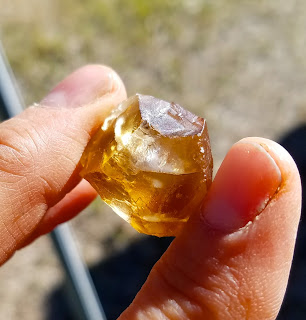One of my favorite places on this trip
was in the northeast corner of Montana
near the very small town of Ft. Peck.
Vickie's daughter lives in the area and graciously agreed to meet us (for the first time!) and show us one of her favorite baculite spots.
To say we would never have found in on our own is an understatement.
As usual, it was in the middle of nowhere.
I have no aspirations to live in wide open country.
I'm too fond of things like grocery stores and cell phone reception.
But being able to visit places like this in a world crawling with 7.5 billion human beings fills my chest with a lightness that in equal measures makes me want to laugh and cry.
And so, with gladness in my heart, I lugged my trusty rock hammer to the top of the hill
and got to work.
This rocky promontory seems to be composed entirely of ancient Cretaceous sea creatures.
And these are not your run-of-the-mill baculites.
Many of them are filled with druzy crystals ranging in color from clear to golden yellow.
As soon as I join a mineral club, I'll find out why many of the crystals are square in shape.
I also uncovered a couple of jewels:
A single well-formed golden crystal resting in a bed of druzy.
Wow!
Some of the other sea creatures include loads of little bivalves, this one half-filled
with some kind of concretion.
Round ammonites.
We all found a few small complete ones but this was the best, found by Don.
And nautiluses!
Vickie's daughter found this amazing specimen and there is a matching nautilus on the reverse side.
I found this perfect little segment laying on the ground.
Hard to believe it is over 65 million years old.
We were guarded in our endeavors by the coolest little dog ever, Chewie.
I want this dog!
The surface hunting around the hill
yielded a whole different world of treasures.
Baculite segments replaced by different colors of minerals with a translucent quality.
Lavender chalcedony!
Cola brown with an interesting orange peel texture.
Half brown, half limestone.
A surprise was this orange-hued crystal, AND...
...out here in the middle of nowhere, Don found this token entitling the holder to 3 cakes of Camay toilet soap for 15¢ instead of the usual price of 25¢.
In an entirely different kind of topography,
only a few miles away,
Pam scored this incredible baculite hidden inside a long nodule.
...jealous...
So that's that for the annual fossil trip out west.
Next year, we're thinking Blue Forest and Utah and...
I can't wait!
Here's some info on the structure of mother of pearl
and how it survives the fossilization process. We found this on several baculites and shells.
This excerpt was borrowed from The Fossil Forum and written by an advanced member.
Nacre consists of rounded or polygonal (normally hexagonal) tablets of aragonite, which is a form of calcium carbonate. The plate-like tablets are arranged in broadly continuous, regular, mutually parallel laminae which are separated by sheets of organic matrix. That matrix is composed of biopolymers such as chitin, lustrin and silk-like proteins.
It’s that unique arrangement, coupled with the fact that the thickness of the aragonite tablets approximates to the wavelength of visible light, which creates the interference pattern of iridescence we call “mother of pearl”.
The other parts of mollusc shells are composed principally of aragonite, with some calcite. Although they’re both calcium carbonates, aragonite is geochemically unstable over long periods of time and readily converts to stable calcite in most shelly fossils by recrystallization during diagenesis and post-diagenetic alteration. Those processes also destroy the organic components of the nacre.
Although it’s possible for the tablet arrangement of the original nacreous structure to be preserved (it’s sometimes replaced as a pseudomorph by the phosphate mineral apatite), the iridescence doesn’t survive in those circumstances. Intact original nacreous structures with iridescence are only seen in two sets of circumstances. Young fossils, or those where something has prevented the recrystallization… and that “something” is most usually petroleum or one of its derivatives.
Famously, for example, the Buckhorn Lagerstätte of Oklahoma is rich in aragonitic shelly fossils preserved with their original iridescent nacre. In fact it’s the oldest deposit in the world which contains such material. It’s a late Middle Pennsylvanian palaeo-seafloor oil seep deposit which became impregnated with asphalt before the sediments lithified and that prevented the nacre from recrystallizing.






















I am fascinated by the cola brown and bi-color baculites. Is there a snowball's chance, in Hell, that you might be willing to part with them? Or better yet, could you point me towards that location? I summer a short 300 miles from there. I'm planning an Iniskim expedition to the Bow River in Canada, eh, this summer, as well. Your blogs are very entertaining. Thanks for keeping science fun. Erik
ReplyDelete